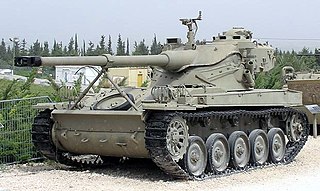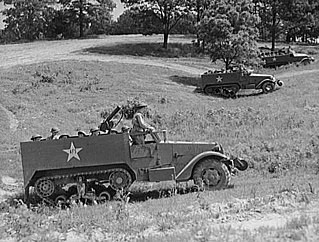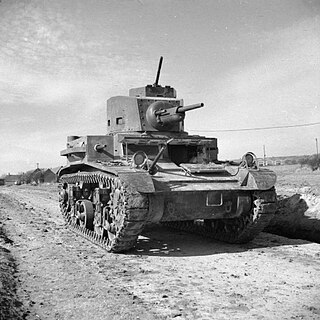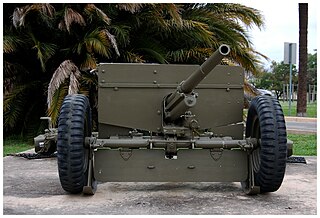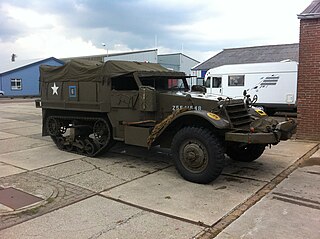| T17E1 Armored Car | |
|---|---|
 | |
| Type | Armored car |
| Place of origin | United States |
| Service history | |
| In service | 1944–1980s |
| Used by | See Operators |
| Wars | World War II 1948 Arab-Israeli war 1958 Lebanon crisis Cuban Revolution Lebanese Civil War Rhodesian Bush War Nicaraguan Revolution |
| Production history | |
| Designer | Chevrolet |
| Produced | October 1942 –April 1944 |
| No. built | 4,094 (3,844 Staghound, 250 Deerhound) |
| Specifications (Staghound Mark I) | |
| Mass | 14 t |
| Length | 17 ft 10 in (5.49 m) |
| Width | 8 ft 10 in (2.69 m) |
| Height | 7 ft 9 in (2.36 m) |
| Crew | 5 |
| Armor | 9 to 44 mm |
Main armament | 1 × 37 mm M6 |
Secondary armament | 2–3 × .30 (7.62 mm) M1919 Browning machine guns |
| Engine | 2 × GMC 270 2 × 97 hp (72 kW) |
| Power/weight | 13.9 hp/tonne |
| Suspension | wheels, 4 x 4 |
Operational range | 450 miles (724 km) |
| Speed | 55 mph (89 km/h) |
The T17 and the T17E1 were two American armored car designs produced during the Second World War. Neither saw service with frontline US forces but the latter was supplied, via the United Kingdom, to British and Commonwealth forces during the war and received the service name Staghound. A number of countries used the Staghound after the war, with some of the vehicles continuing to serve into the 1980s.

The United States of America (USA), commonly known as the United States or America, is a country composed of 50 states, a federal district, five major self-governing territories, and various possessions. At 3.8 million square miles, the United States is the world's third or fourth largest country by total area and is slightly smaller than the entire continent of Europe's 3.9 million square miles. With a population of over 327 million people, the U.S. is the third most populous country. The capital is Washington, D.C., and the largest city by population is New York City. Forty-eight states and the capital's federal district are contiguous in North America between Canada and Mexico. The State of Alaska is in the northwest corner of North America, bordered by Canada to the east and across the Bering Strait from Russia to the west. The State of Hawaii is an archipelago in the mid-Pacific Ocean. The U.S. territories are scattered about the Pacific Ocean and the Caribbean Sea, stretching across nine official time zones. The extremely diverse geography, climate, and wildlife of the United States make it one of the world's 17 megadiverse countries.
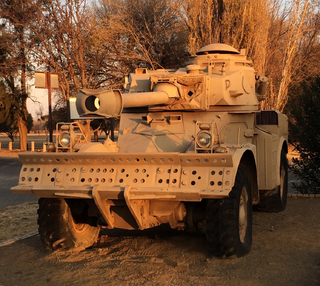
A military armoredcar is a lightweight wheeled armored fighting vehicle, historically employed for reconnaissance, internal security, armed escort, and other subordinate battlefield tasks. With the gradual decline of mounted cavalry, armored cars were developed for carrying out duties formerly assigned to horsemen. Following the invention of the tank, the armored car remained popular due to its comparatively simplified maintenance and low production cost. It also found favor with several colonial armies as a cheaper weapon for use in underdeveloped regions. During World War II, most armored cars were engineered for reconnaissance and passive observation, while others were devoted to communications tasks. Some equipped with heavier armament could even substitute for tracked combat vehicles in favorable conditions—such as pursuit or flanking maneuvers during the North African Campaign.

The United Kingdom, officially the United Kingdom of Great Britain and Northern Ireland but more commonly known as the UK or Britain, is a sovereign country lying off the north-western coast of the European mainland. The United Kingdom includes the island of Great Britain, the north-eastern part of the island of Ireland and many smaller islands. Northern Ireland is the only part of the United Kingdom that shares a land border with another sovereign state—the Republic of Ireland. Apart from this land border, the United Kingdom is surrounded by the Atlantic Ocean, with the North Sea to the east, the English Channel to the south and the Celtic Sea to the south-west, giving it the 12th-longest coastline in the world. The Irish Sea lies between Great Britain and Ireland. With an area of 242,500 square kilometres (93,600 sq mi), the United Kingdom is the 78th-largest sovereign state in the world. It is also the 22nd-most populous country, with an estimated 66.0 million inhabitants in 2017.












